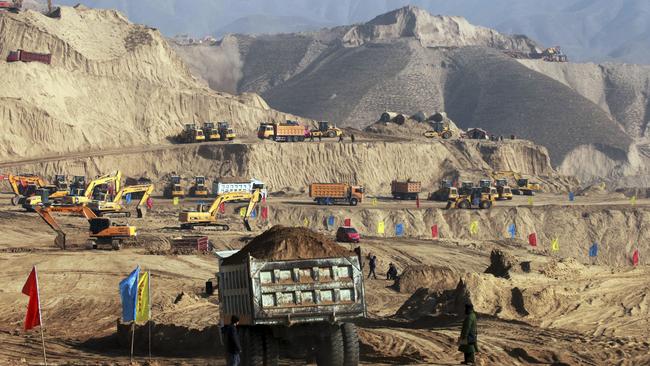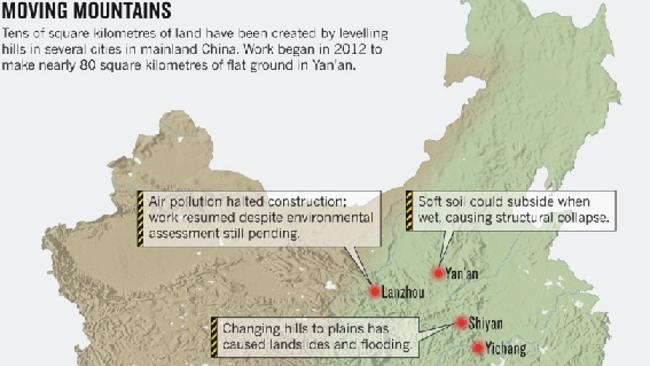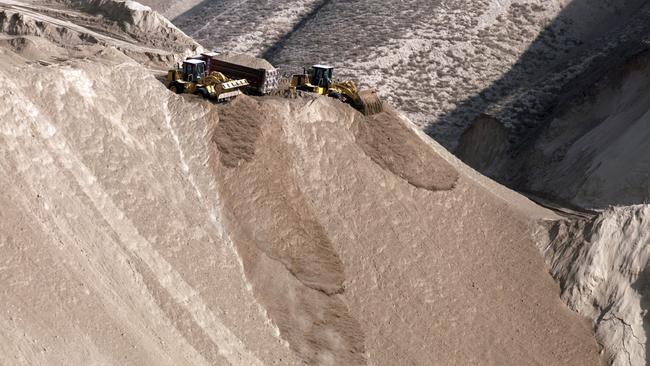China flattens mountains in a bid to make room for its growing population
EXTREME engineering projects in China are chopping the tops off mountains to help its spilling population. But it could turn into a whole heap of trouble.

WHEN the most populated country on Earth continues to rapidly grow, what does one do?
China being no stranger to ambitious building projects has taken to literally moving mountains in order to generate more land.
The idea is simple: lop off the tops of the mountains and use it to fill in the valleys below to create a flat, livable area of land.
Science and environment journal Nature has reported that tens of square kilometres of flat land has been created in the cities of Chongqing, Shiyan, Yichang, Lanzhou and Yan’an, with the latter looking to double its current area through flattening mountains.
As well as a place for the population to spill onto it’s expected the new land will generate billions of renminbi (local currency) through sales and leasing, while also providing more space for agriculture.

But all is not as simple as it sounds.
According to the article, engineers have gone steaming into the project without thinking or swotting up first.
“The consequences of these unprecedented programs have not been thought through — environmentally, technically or economically. There has been too little modelling of the costs and benefits of land creation.”
The whole process is proving an environmental and engineering disaster. This looming calamity all points to a severe lack of research and expertise combined with a desperate rush to create more land while turning a blind eye to the implications.

In Yan’an for instance, the mountain tops here consist of thick million-year-old deposits of windblown silt. This was found out as research was carried out three months after construction began. Nature describes that “such soft soils can subside when wet, causing structural collapse”, something that could cause significant costs further down the track, or even posing a risk to safety.
Work here has also seen the air turn brown with dust as a result of workers working on windy days without dampening the soil first as they should.
In the city of Shiyan, changing hills to plains has caused landslides and flooding. The initiative diverted water from rivers into canals but ended up causing greater soil erosion and depositing sediment into local water sources.
“Land-creation projects are already causing air and water pollution, soil erosion and geological hazards such as subsidence. They destroy forests and farmlands and endanger wild animals and plants,” Nature explains.
“Many land-creation projects in China ignore environmental regulations, because local governments tend to prioritise making money over protecting nature.”

But there’s no evidence mountain flattening will even be a lucrative move. The estimated $16 billion cost over the ten year project could take decades to recoup, if at all. The soft infill soil will require at least a decade to stabilise before building work can take place. By then investors could have lost patience or be put off altogether.

So China is learning that moving mountains really is as difficult as it sounds. To fix the situation the article suggests not only allocating funds to research from geologists and hydrogeologists but also collaborating with international bodies that have the right expertise in order to get the job done properly. It also mentions governments should work with economists to see if a project is financially worthwhile before breaking ground.
Worryingly construction work continues to go ahead. While it might seem a bit of a no-brainer, a set of guidelines should be put in place before scything off the tops of mountains to make way for more mega cities. But convincing determined local governments to adopt this could be an even harder task.



